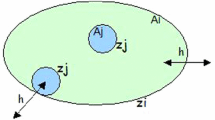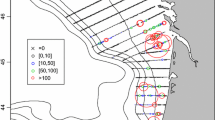Abstract
Hydroacoustic technology provides ground tools for the estimation of abundance and spatial distribution of pelagic species. The final products of such surveys, the interpolated choropleth maps, are based on a Geostatistical analysis of the acoustic measurements to minimise, as much as possible, the interpolation error, and to quantify uncertainty. The current study is based on fisheries acoustic measurements and satellite images covering the sea area of Thermaikos Gulf over the years 1996, 1997 and 1998. Spatial interpolations describing the abundance and distribution of small pelagic species in the research area, as well as sea surface temperature (SST), Chlorophyll-a content (SSC) and average depth, were produced, based on Ordinary and Universal Kriging and Co-Kriging Geostatistical methods. The results of the Geostatistical analysis showed that the Co-Kriging spatial interpolation method produced the best results regarding fish abundance when SST and average depth variables were included in the model. The latter indicates that there is an existing spatial cross-correlation between fish abundance and the environmental variables. Consequently, the potential reduction of the overall error in the estimation process, as presented in this study, is very significant, particularly with regard to error reduction in stock assessment and management.





Similar content being viewed by others
References
Agenbag, J. J., A. J. Richardson, H. Demarcq, P. Fréon, S. Weeks & F. A. Shillington, 2003. Relating local abundance of South African pelagic fish species to environmental variables using generalized additive and linear models. Progress in Oceanography 59: 275–300.
Agostini, V. N. & A. Bakun, 2002. “Ocean trials” in the Mediterranean Sea: physical mechanisms potentially structuring reproductive habitat suitability (with example application to European anchovy, Engraulis encrasicolus). Fisheries Oceanography 11: 129–142.
Armstrong, M., D. Renard & P. Berthou, 1989. Applying geostatistics to the estimation of a population of bivalves. ICES/CM/1989/K:37.
Azzali, M., G. Buracchi, S. Conti, S. Gambetti & M. Luna, 1985. Relationship between the forms of pelagic fish distribution and nycthemeral periods. A tentative model of behaviour. Oebalia 11: 471–488.
Bendat, J. S. & A. G. Piersol, 1971. Random data: analysis and measurement procedures. Wiley-Interscience, New York.
Bradley, R. & J. Haslett, 1992. High-interaction diagnostics for geostatistical models of spatially referenced data. The Statistician 41: 371–380.
Castillo, J., M. A. Barbieri & A. Gonzalez, 1996. Relationships between sea surface temperature, salinity, and pelagic fish distribution off northern Chile. ICES Journal of Marine Science 53: 139–146.
Chen, I. C., P. F. Lee & W. N. Tzeng, 2005. Distribution of albacore (Thunnus alalunga) in the Indian Ocean and its relation to environmental factors. Fisheries Oceanography 14: 71–80.
Cliff, A. D. & J. K. Ord, 1981. Spatial Processes: Models and Applications. Pion, London.
Cressie, N. A. C., 1993. Statistics for Spatial Data. John Wiley & Sons, New York, New York.
Deutsch, C. V. & A. G. Journel, 1998. GSLIB: Geostatistical Software Library and User’s Guide. Oxford University Press, New York, New York.
Fiedler, P. C. & H. J. Bernard, 1987. Tuna aggregation and feeding near fronts observed in satellite imagery. Continental Shelf Research 7: 871–881.
Foote, K. G., 1987. Fish target strengths for use in echo integrator surveys. Journal of the Acoustical Society of America 82: 981–987.
Fréon, P. & O. A. Misund, 1999. Dynamics of Pelagic Fish Distribution and Behaviour: Effects on Fisheries and Stock Assessment. Fishing News Books, Oxford.
Fréon, P., P. Cury, L. Shannon & C. Roy, 2005. Sustainable exploitation of small pelagic fish stocks challenged by environmental and ecosystem changes: a review. Bulletin of Marine Science 76: 385–462.
Georgakarakos, S., D. Koutsoubas & V. Valavanis, 2006. Time series analysis and forecasting techniques applied on loliginid and ommastrephid landings in Greek waters. Fisheries Research 78: 55–71.
Giannoulaki, M., A. Machias, C. Koutsikopoulos & S. Somarakis, 2006. The effect of coastal topography on the spatial structure of anchovy and sardine. ICES Journal of Marine Science 63: 650–662.
Giannoulaki, M., A. Machias, S. Somarakis & N. Tsimenides, 2005. The spatial distribution of anchovy and sardine in the northern Aegean Sea in relation to hydrographic regimes. Belgian Journal of Zoology 135: 151–156.
Goovaerts, P., 1997. Geostatistics for Natural Resources Evaluation. Oxford University Press, New York.
Haralabous, J. & S. Georgakarakos, 1996. Artificial Neural Networks as a tool for species identification of fish schools. ICES Journal of Marine Science 53: 173–180.
Hensen, V., 1911. Das Leben im Ozean nach Zahlungen seiner Bewohner. Übersicht und Resultaten der quantitativen Untersuchungen. Ergebn. Plankton Expdn. der Humboldt Stiftung V.
Holland, D., W. M. Cox, R. Scheffe, A. Cimorelli, D. Nychka & P. Hopke, 2003. Spatial Prediction of Air Quality Data. Environmental Manager: 31–35.
Horne, J. K., P. E. Smith & D. C. Schneider, 1999. Comparative examination of scale-explicit biological and physical processes: recruitment of Pacific hake. Canadian Journal of Fisheries and Aquatic Sciences 56: 1–10.
Isaaks, E. H. & R. M. Srivastava, 1989. Applied Geostatistics. Oxford University Press, New York.
Journel, A. G. & C. J. Huijbregts, 1978. Mining Geostatistics. Academic Press, London.
Kerstan, S., 1993. Relationships between pilchard distribution and environmental factors. Marine science for a sustainable future. In Proceedings of the 8th South African Marine Science Symposium, Langebaan.
Kontoyiannis, H., V. H. Kourafalou & V. Papadopoulos, 2003. The seasonal characteristics of the hydrology and circulation in the Northwest Aegean Sea (Eastern Mediterranean): observations and modelling. Journal of Geophysical Research-Oceans 108: 3302.
Knudsen, H. P., 1990. The Bergen echo integrator: an introduction. Journal du Conseil Internation pour l’Exploration de la Mer 47: 167–174.
Koutsikopoulos, C. & N. Lacroix, 1992. Distribution, abundance of sole (Solea solea L.) eggs, larvae in the Bay of Biscay between 1986 and 1989. Netherlands Journal of Sea Research 29: 81–91.
Koutsikopoulos, C. & B. Le Cann, 1996. Physical processes and hydrological structures related to the Bay of Biscay anchovy. Scientia Marina 60: 9–19.
Laevastu, T. & M. L. Hayes, 1981. Fisheries Oceanography and Ecology. Fishing News Books, Oxford.
Lasker, R., 1978. The relation between oceanographic conditions and larval anchovy food in the California Current: identification of factors contributing to recruitment failure. Rapport Réunion du Conseil International pour l’ Exploration de la Mer 173: 212–230.
Laurs, R. M., P. C. Fiedler & D. R. Montgomery, 1984. Albacore tuna catch distributions relative to environmental features observed from satellites. Deep-Sea Research 31: 1085–1099.
MacLennan, D. N. & I. G. MacKenzie, 1988. Precision of acoustic fish stock estimates. Canadian Journal of Fisheries and Aquatic Sciences 45: 605–616.
Maravelias, C. D., 1999. Habitat selection and clustering of a pelagic fish: effects of topography and bathymetry on species dynamics. Canadian Journal of Fisheries and Aquatic Sciences 56: 437–450.
Maravelias, C. D., D. G. Reid, E. J. Simmonds & J. Haralabous, 1996. Spatial Analysis and Mapping of Acoustic Survey Data in the presence of High Local Variability: Geostatistical Application to North Sea Herring (Clupea harengus). Canadian Journal of Fisheries and Aquatic Sciences 53: 1497–1505.
Matheron, G., 1971. The theory of regionalized variables and its applications. Ecole Nationale Supérieure des Mines de Paris, Fontainebleau.
McBratney, A. B., I. O. A. Odeh, T. F. A. Bishop, M. S. Dunbar & T. M. Shatar, 2000. An overview of pedometric techniques for use in soil survey. Geoderma 97: 293–327.
Panatier, Y., 1996. Statistics and Computing. VARIOWIN Software for Spatial Data Analysis in 2D. Springer-Verlag, New York.
Papoulis, A., 1965. Probability Random Variables and Stochastic Processes. MacGraw Hill, Kogakusha, Tokyo.
Paramo, J. & R. Roa, 2003. Acoustic-geostatistical assessment and habitat-abundance relations of small pelagic fish from the Colombian Caribbean. Fisheries Research 60: 309–319.
Petitgas, P., 1993. Geostatistics for fish stock assessments: A review and an acoustic application. ICES Journal of Marine Science 50: 285–298.
Petitgas, P., D. Reid, P. Carrera, M. Iglesias, S. Georgakarakos, B. Liorzou & J. Masse, 2001. On the relation between schools, clusters of schools, and abundance in pelagic-fish stocks. ICES Journal of Marine Science 58: 1150–1160.
Poulos, S. E., G. T. Chronis, M. B. Collins & V. Lykousis, 2000. Thermaikos Gulf Coastal System, NW Aegean Sea: an overview of water/sediment fluxes in relation to air-land-ocean interactions and human activities. Journal of Marine Systems 25: 47–76.
Rossi, R. E., D. J. Mula, A. G. Journel & E. H. Franz, 1992. Geostatistical tools for modeling and interpreting ecological spatial dependence. Ecological Monographs 2: 277–314.
Royle, J. A. & L. M. Berliner, 1999. A Hierarchical Approach to Multivariate Spatial Modeling and Prediction. Journal of Agricultural, Biological and Environmental Statistics 4: 29–56.
Santos, A. M. P., 2000. Fisheries oceanography using satellite and airborne remote sensing methods: a review. Fisheries Research 49: 1–20.
Sharp, G. D. & D. R. McLain, 1993. Fisheries, El Nino-southern oscillation and upper-ocean temperature records: an Eastern Pacific example. Oceanography 6: 13–22.
Simard, Y., D. Lavoie & F. J. Saucier, 2002. Channel head dynamics: Capelin (Mallotus villosus) aggregation in the tidally-driven upwelling system of the Saguenay-St. Lawrence Marine Park’s whale feeding ground. Canadian Journal of Fisheries and Aquatic Sciences 59: 197–210.
Simard, Y., P. Legendre, G. Lavoie & D. Marcotte, 1992. Mapping, estimating biomass, and optimizing sampling programs for spatially autocorrelated data: case study of the northern shrimp (Pandalus borealis). Canadian Journal of Fisheries and Aquatic Sciences 49: 32–45.
Stefánsson, G., 1996. Analysis of ground fish survey abundance data: combining the GLM and delta approaches. ICES Journal of Marine Science 53: 577–826.
Stergiou, K. I., E. D. Christou, D. Georgopoulos, A. Zenetos & E. Souvermezoglou, 1997. The Hellenic Seas: physics, chemistry, biology and fisheries. Oceanology and Marine Biology: An Annual Review 35: 415–538.
Sullivan, P. J., 1991. Stock abundance estimation using depth-dependent trends and spatially correlated variation. Canadian Journal of Fisheries and Aquatic Sciences 48: 1691–1703.
Swartzman, G. L., W. Stuetzle, K. Kulman & M. Powojowski, 1994. Relating the distribution of pollock schools in the Bering Sea to environmental factors. ICES Journal of Marine Science 51: 481–492.
Tragou, E., V. Zervakis, E. Papageorgiou, S. Stavrakakis & V. Lykousis, 2005. Monitoring the physical forcing of resuspension events in the Thermaikos Gulf - NW Aegean during 2001–2003. Continental Shelf Research 25: 2315–2331.
Tsimenides, N., G. Bazigos, S. Georgakarakos, A. Kapantagakis, 1992. Distribution of acoustic pelagic fish populations in the northern Aegean Sea. In Proceedings of the 1st World Fisheries Congress, Athens, 5: 33–42.
Valavanis, V. D., S. Georgakarakos, A. Kapantagakis, A. Palialexis & I. Katara, 2004. A GIS environmental modelling approach to essential fish habitat designation. Ecological Modelling 178: 417–427.
Wackernagel, H., 1995. Multivariate Geostatistics. Springer-Verlag, Berlin, Germany.
Ware, D. M. & R. E. Thomson, 2005. Bottom-Up Ecosystem Trophic Dynamics Determine Fish Production in the Northeast Pacific. Science 308: 1280–1285.
Webster, R. & M. A. Oliver, 2001. Geostatistics for Environmental Scientists. Wiley, Chichester.
Zar, J. H., 1974. Biostatistical Analysis. Prentice-Hall International, London.
Zervakis, V., A. P. Karageorgis, H. Kontoyiannis, V. Papadopoulos & V. Lykousis, 2005. Hydrology, circulation and distribution of particulate matter in Thermaikos Gulf (NW Aegean Sea), during September 2001-October 2001 and February 2002. Continental Shelf Research 25: 2332–2349.
Acknowledgements
In this work, the acoustic data collection and processing were supported by the Commission of the European Union (CLUSTER/FAIR, 1997). We would also like to thank V. Trygonis and D. Markopoulou and N. Fletcher for the initial analysis of the data.
Author information
Authors and Affiliations
Corresponding author
Additional information
Guest editor: V. D. Valavanis
Essential Fish Habitat Mapping in the Mediterranean
Rights and permissions
About this article
Cite this article
Georgakarakos, S., Kitsiou, D. Mapping abundance distribution of small pelagic species applying hydroacoustics and Co-Kriging techniques. Hydrobiologia 612, 155–169 (2008). https://doi.org/10.1007/s10750-008-9484-z
Published:
Issue Date:
DOI: https://doi.org/10.1007/s10750-008-9484-z




